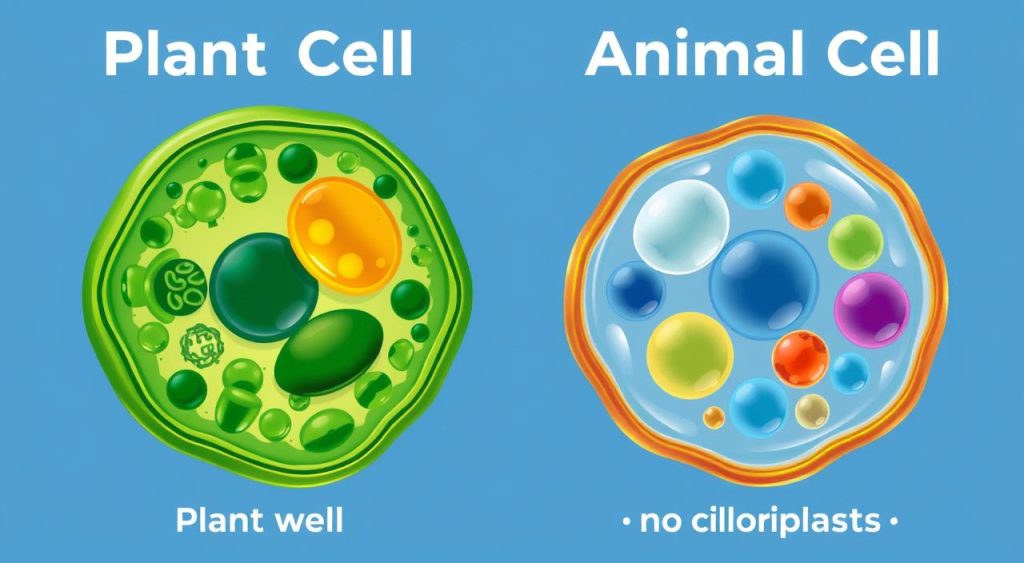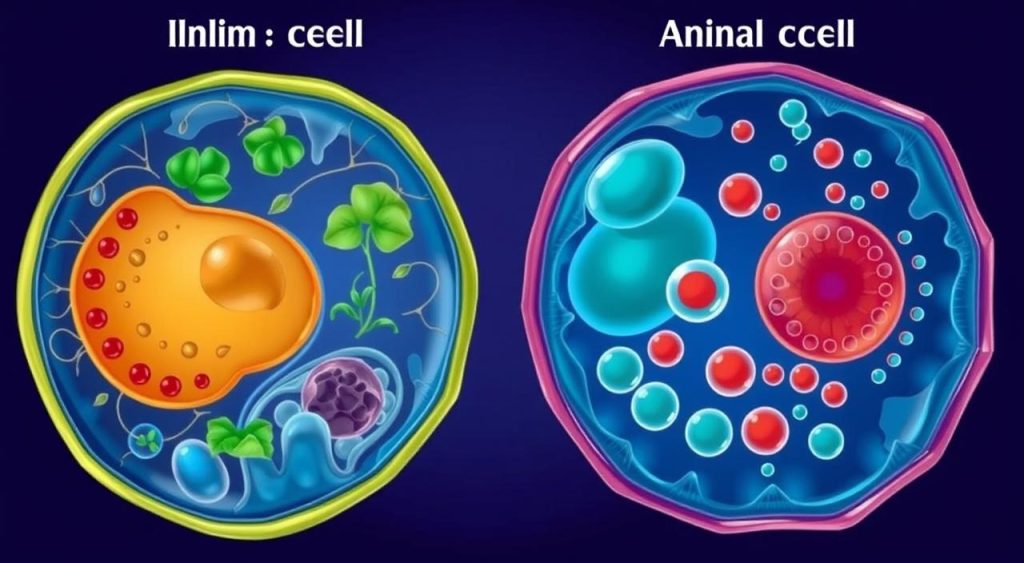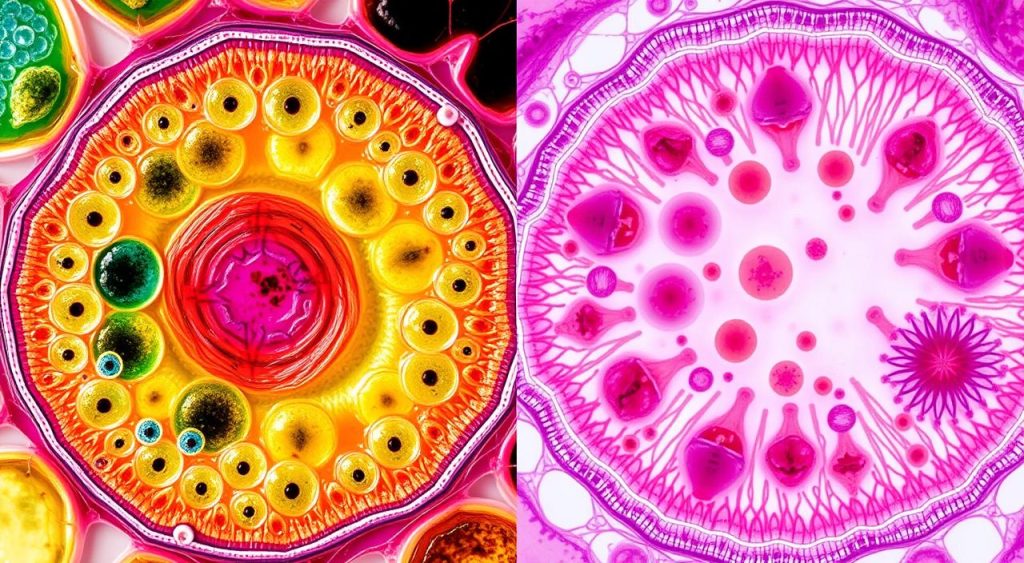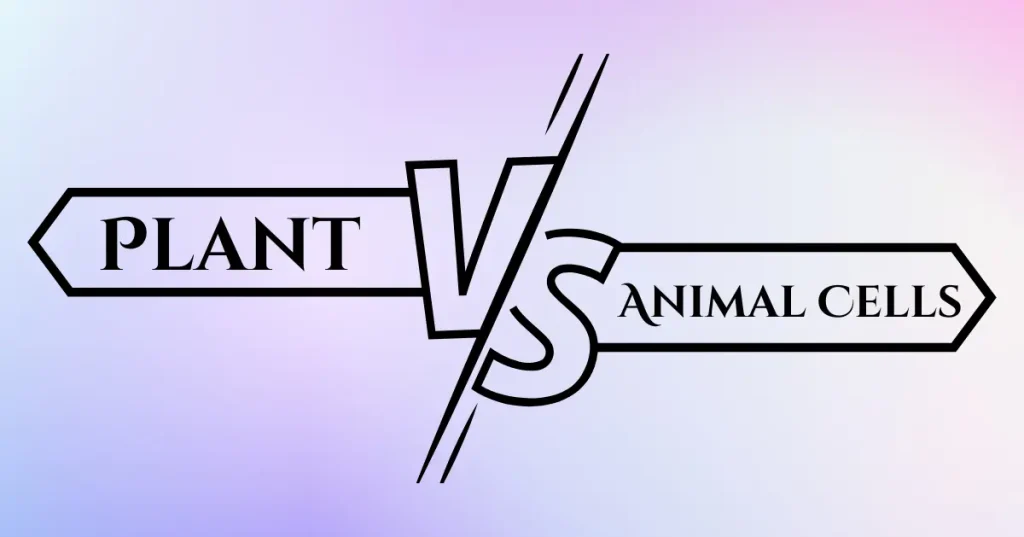What makes plant and animal cells different? Knowing the difference is key. It helps us see what makes each cell special. This is important in biology and medicine.
Every living thing is made of cells. Plant and animal cells have different structures. This affects how they work and what they do.

Understanding Cell Basics and Their Importance
Cells are the basic building blocks of life. Knowing how they work helps us understand living things better. Organelles like the nucleus and mitochondria help with energy and growth. The cell wall in plants and the cell membrane in animals are key to their survival.
Also Read: Weather vs Climate: Key Differences Explained
Cells do many important things to keep us alive. For example, mitochondria make energy, and chloroplasts make food from sunlight. The cell wall and membrane help cells talk to their surroundings and move things in and out.
Studying cells has taught us a lot about life. By looking at cells, scientists learn new things and find ways to help people. The cell wall and membrane are just a few of the cool things about cells.
| Cell Type | Cell Wall | Cell Membrane |
|---|---|---|
| Plant Cell | Rigid, provides structural support | Semi-permeable, regulates transport |
| Animal Cell | None | Semi-permeable, regulates transport |
What Are Eukaryotic Cells?
Eukaryotic cells have a true nucleus and other organelles. They are found in plants, animals, and fungi. These cells are complex and important.
The Role of Cells in Living Organisms
Cells are vital for life. They are the basic units of life. Understanding cells helps us grasp the complexity of living things.
Read More: DNA vs RNA: Understanding the Key Differences
Common Features of All Cellular Structures
All cells have some things in common. They have organelles, a cell membrane, and a way to make energy. These things help cells work and talk to their surroundings.
The Key Difference Between Plant and Animal Cells
Plant and animal cells are very different. They have different organelles for their functions and energy. Microscopy helps us see these differences clearly.
Plant cells have a strong cell wall. This keeps their shape. Animal cells have a flexible cell membrane. This lets them move easily.

Plant cells have chloroplasts for photosynthesis. Animal cells use mitochondria for energy. Knowing these differences helps us understand each cell’s special traits.
Microscopy lets us study cell structure and organelles. This knowledge is useful in biology, medicine, and agriculture. It helps us understand cell processes better.
Methods for Identifying Cell Types Under Microscope
Knowing how cells work is key in biology and microbiology. By looking at cell structures and their similarities, scientists can tell what kind of cells they are. This is very important in microbiology to understand how tiny living things work.
In biology, learning about cell functions has helped us a lot. Scientists use special tools and techniques to see and study cells. This helps us in many areas like medicine and science.

Studying cells has many uses. For example, knowing how human cells work can help make new medicines. Also, seeing how different cells are alike can lead to new inventions.
| Cell Type | Function | Similarities |
|---|---|---|
| Animal Cells | Basic cellular functions | Similarities in cellular structure and function with plant cells |
| Plant Cells | Photosynthesis and cellular functions | Similarities in cellular structure and function with animal cells |
In conclusion, knowing about cell types is very important in biology and microbiology. Scientists use special tools to study cells. This helps us learn more about life and find new uses for it.
Conclusion: Applying Your Knowledge of Cellular Differences
The big difference between eukaryotic cells in plants and animals is key. It helps us see how life is so varied. Knowing how these plant and animal cells work helps us understand life better.
Knowing how cells are different helps us in many ways. It’s useful in biology, medicine, and even farming. This knowledge helps us make smart choices and learn more about the world.
If you’re into learning about life’s basics, knowing about eukaryotic cells is important. It’s the start of many cool discoveries. Keep learning about cells and enjoy finding out how life is so complex and beautiful.
FAQ
What are the key differences between plant and animal cells?
Plant cells have a cell wall and chloroplasts for photosynthesis. They also have large vacuoles. Animal cells have a cell membrane and no chloroplasts. They have smaller vacuoles.
What are the common features of all cellular structures?
All cells share common features. They have organelles like the nucleus and mitochondria. They also have cell membranes and can perform important functions.
How can you identify cell types under a microscope?
To identify cells, use staining techniques. Look at the cell wall, shape, and organelles. This helps tell if it’s a plant or animal cell.
What is the role of cells in living organisms?
Cells are the basic units of life. They carry out vital processes. This includes metabolism, growth, and reproduction, which are key for survival.
How do plant and animal cells differ in terms of energy production and storage?
Plant cells make their own energy through photosynthesis. They store energy as starch. Animal cells get energy from mitochondria. They store energy as glycogen.
What are eukaryotic cells, and how do they differ from other cell types?
Eukaryotic cells are found in plants, animals, fungi, and protists. They have a membrane-bound nucleus and organelles. They are larger and more complex than prokaryotic cells.



